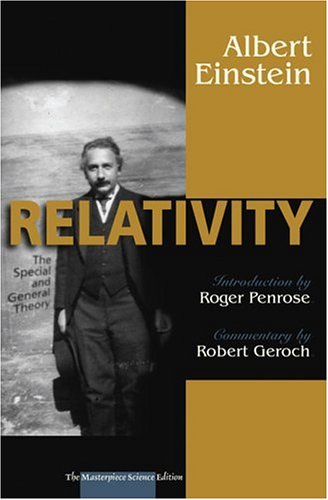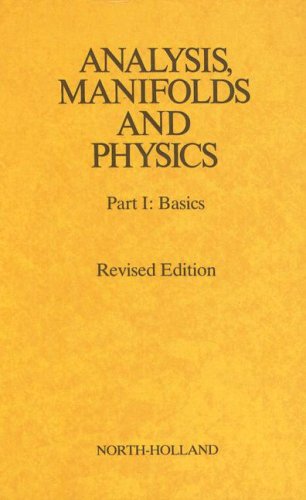Albert Einstein, Roger Penrose, Robert Geroch, David C. Cassidy0131862618, 9780131951907, 9780131862616
Section 17. Space-Time
Minkowski’s viewpoint represents a “geometrization” of relativity. These ideas have, over the years, come to the forefront: They reflect the perspective of the majority of physicists working in relativity today. Let us expand on this viewpoint. The fundamental notion is that of an event, which we think of as a physical occurrence having negligibly small extension in both space and time. That is, an event is “small and quick,” such as the explosion of a firecracker or the snapping of your fingers. Now consider the collection of all possible events in the universe—all events that have ever happened, all that are happening now, and all that will ever happen; here and elsewhere. This collection is called space-time. It is the arena in which physics takes place in relativity. The idea is to recast all statements about goings-on in the physical world into geometrical structures within this space-time. In a similar vein, you might begin the study of plane geometry by introducing the notion of a point (analogous to an event) and assembling all possible points into the plane (analogous to space-time). This plane is the arena for plane geometry, and each statement that is part of plane geometry is to be cast as geometrical structure within this plane. This space-time is a once-and-for-all picture of the entire physical world. Nothing “happens” there; things just “are.” A physical particle, for example, is described in the language of space-time by giving the locus of all events that occur “right at the particle.” The result is a certain curve, or path, in space-time called the world-line of the particle. Don’t think of the particle as “traversing” its world-line in the same sense that a train traverses its tracks. Rather, the world-line represents, once and for all, the entire life history of the particle, from its birth to its death. The collision of two particles, for example, would be represented geometrically by the intersection of their world-lines. The point of intersection—a point common to both curves; an event that is “right at” both particles—represents the event of their collision. In a similar way, more complicated physical goings-on—an experiment in particle physics, for example, or a football game—are incorporated into the fabric of space-time. One example of “physical goings-on” is the reference frame that Einstein uses in his discussion of special relativity. How is this incorporated into space-time? The individuals within a particular reference frame assign four numbers, labeled x, y, z, t, to each event in space-time. The first three give the spatial location of the event according to these observers, the last the time of the event. These numbers completely and uniquely characterize the event. In geometrical terms, a frame of reference gives rise to a coordinate system on space-time. In a similar vein, in plane geometry a coordinate system assigns two numbers, x and y, to each point of the plane. These numbers completely and uniquely characterize that point. The statement “the plane is two-dimensional” means nothing more and nothing less than that precisely two numbers are required to locate each point in the plane. Similarly, “space-time is four-dimensional” means nothing more and nothing less than that precisely four numbers are required to locate each event in space-time. That is all there is to it! You now understand “four-dimensional space-time” as well as any physicist. Note that the introduction of four-dimensional space-time does not say that space and time are “equivalent” or “indistinguishable.” Clearly, space and time are subjectively different entities. But a rather subtle mixing of them occurs in special relativity, making it convenient to introduce this single entity, space-time. In plane geometry, we may change coordinates, i.e., relabel the points. It is the same plane described in a different way (in that a given point is now represented by different numbers), just as the land represented by a map stays the same whether you use latitude/longitude or GPS coordinates. We can now determine formulae expressing the new coordinate-values for each point of the plane in terms of the old coordinate-values. Similarly, we may change coordinates in space-time, i.e., change the reference frame therein. And, again, we can determine formulae relating the new coordinate-values for each space-time event to the old coordinate-values for that event. This, from Minkowski’s geometrical viewpoint, is the substance of the Lorentz-transformation formulae in Section 11. A significant advantage of Minkowski’s viewpoint is that it is particularly well-adapted also to the general theory of relativity. We shall return to this geometrical viewpoint in our discussion of Section 27.
Table of contents :
Cover.pdf……Page 1
1.pdf……Page 2
2.pdf……Page 3
3.pdf……Page 4
4.pdf……Page 5
5.pdf……Page 6
6.pdf……Page 7
7.pdf……Page 8
8.pdf……Page 9
9.pdf……Page 10
10.pdf……Page 11
11.pdf……Page 12
12.pdf……Page 13
13.pdf……Page 14
14.pdf……Page 15
15.pdf……Page 16
16.pdf……Page 17
17.pdf……Page 18
18.pdf……Page 19
19.pdf……Page 20
20.pdf……Page 21
21.pdf……Page 22
22.pdf……Page 23
23.pdf……Page 24
24.pdf……Page 25
25.pdf……Page 26
26.pdf……Page 27
27.pdf……Page 28
28.pdf……Page 29
29.pdf……Page 30
30.pdf……Page 31
31.pdf……Page 32
32.pdf……Page 33
33.pdf……Page 34
34.pdf……Page 35
35.pdf……Page 36
36.pdf……Page 37
37.pdf……Page 38
38.pdf……Page 39
39.pdf……Page 40
40.pdf……Page 41
41.pdf……Page 42
42.pdf……Page 43
43.pdf……Page 44
44.pdf……Page 45
45.pdf……Page 46
46.pdf……Page 47
47.pdf……Page 48
48.pdf……Page 49
49.pdf……Page 50
50.pdf……Page 51
51.pdf……Page 52
52.pdf……Page 53
53.pdf……Page 54
54.pdf……Page 55
55.pdf……Page 56
56.pdf……Page 57
57.pdf……Page 58
58.pdf……Page 59
59.pdf……Page 60
60.pdf……Page 61
61.pdf……Page 62
62.pdf……Page 63
63.pdf……Page 64
64.pdf……Page 65
65.pdf……Page 66
66.pdf……Page 67
67.pdf……Page 68
68.pdf……Page 69
69.pdf……Page 70
70.pdf……Page 71
71.pdf……Page 72
72.pdf……Page 73
73.pdf……Page 74
74.pdf……Page 75
75.pdf……Page 76
76.pdf……Page 77
77.pdf……Page 78
78.pdf……Page 79
79.pdf……Page 80
80.pdf……Page 81
81.pdf……Page 82
82.pdf……Page 83
83.pdf……Page 84
84.pdf……Page 85
85.pdf……Page 86
86.pdf……Page 87
87.pdf……Page 88
88.pdf……Page 89
89.pdf……Page 90
90.pdf……Page 91
91.pdf……Page 92
92.pdf……Page 93
93.pdf……Page 94
94.pdf……Page 95
95.pdf……Page 96
96.pdf……Page 97
97.pdf……Page 98
98.pdf……Page 99
99.pdf……Page 100
100.pdf……Page 101
101.pdf……Page 102
102.pdf……Page 103
103.pdf……Page 104
104.pdf……Page 105
105.pdf……Page 106
106.pdf……Page 107
107.pdf……Page 108
108.pdf……Page 109
109.pdf……Page 110
110.pdf……Page 111
111.pdf……Page 112
112.pdf……Page 113
113.pdf……Page 114
114.pdf……Page 115
115.pdf……Page 116
116.pdf……Page 117
117.pdf……Page 118
118.pdf……Page 119
119.pdf……Page 120
120.pdf……Page 121
121.pdf……Page 122
122.pdf……Page 123
123.pdf……Page 124
124.pdf……Page 125
125.pdf……Page 126
126.pdf……Page 127
127.pdf……Page 128
128.pdf……Page 129
129.pdf……Page 130
130.pdf……Page 131
131.pdf……Page 132
132.pdf……Page 133
133.pdf……Page 134
134.pdf……Page 135
135.pdf……Page 136
136.pdf……Page 137
137.pdf……Page 138
138.pdf……Page 139
139.pdf……Page 140
140.pdf……Page 141
141.pdf……Page 142
142.pdf……Page 143
143.pdf……Page 144
144.pdf……Page 145
145.pdf……Page 146
146.pdf……Page 147
147.pdf……Page 148
148.pdf……Page 149
149.pdf……Page 150
150.pdf……Page 151
151.pdf……Page 152
152.pdf……Page 153
153.pdf……Page 154
154.pdf……Page 155
155.pdf……Page 156
156.pdf……Page 157
157.pdf……Page 158
158.pdf……Page 159
159.pdf……Page 160
160.pdf……Page 161
161.pdf……Page 162
162.pdf……Page 163
163.pdf……Page 164
164.pdf……Page 165
165.pdf……Page 166
166.pdf……Page 167
167.pdf……Page 168
168.pdf……Page 169
169.pdf……Page 170
170.pdf……Page 171
171.pdf……Page 172
172.pdf……Page 173
173.pdf……Page 174
174.pdf……Page 175
175.pdf……Page 176
176.pdf……Page 177
177.pdf……Page 178
178.pdf……Page 179
179.pdf……Page 180
180.pdf……Page 181
181.pdf……Page 182
182.pdf……Page 183
183.pdf……Page 184
184.pdf……Page 185
185.pdf……Page 186
186.pdf……Page 187
187.pdf……Page 188
188.pdf……Page 189
189.pdf……Page 190
190.pdf……Page 191
191.pdf……Page 192
192.pdf……Page 193
193.pdf……Page 194
194.pdf……Page 195
195.pdf……Page 196
196.pdf……Page 197
197.pdf……Page 198
198.pdf……Page 199
199.pdf……Page 200
200.pdf……Page 201
201.pdf……Page 202
202.pdf……Page 203
203.pdf……Page 204
204.pdf……Page 205
205.pdf……Page 206
206.pdf……Page 207
207.pdf……Page 208
208.pdf……Page 209
209.pdf……Page 210
210.pdf……Page 211
211.pdf……Page 212
212.pdf……Page 213
213.pdf……Page 214
214.pdf……Page 215
215.pdf……Page 216
216.pdf……Page 217
217.pdf……Page 218
218.pdf……Page 219
219.pdf……Page 220
220.pdf……Page 221
221.pdf……Page 222
222.pdf……Page 223
223.pdf……Page 224
224.pdf……Page 225
225.pdf……Page 226
226.pdf……Page 227
227.pdf……Page 228
228.pdf……Page 229
229.pdf……Page 230
230.pdf……Page 231
231.pdf……Page 232
232.pdf……Page 233
233.pdf……Page 234
234.pdf……Page 235
235.pdf……Page 236
236.pdf……Page 237
237.pdf……Page 238
238.pdf……Page 239
239.pdf……Page 240
240.pdf……Page 241
241.pdf……Page 242
242.pdf……Page 243
243.pdf……Page 244
244.pdf……Page 245
245.pdf……Page 246
246.pdf……Page 247
247.pdf……Page 248
248.pdf……Page 249
249.pdf……Page 250
250.pdf……Page 251
251.pdf……Page 252
252.pdf……Page 253
253.pdf……Page 254
254.pdf……Page 255
255.pdf……Page 256
256.pdf……Page 257
257.pdf……Page 258
258.pdf……Page 259
259.pdf……Page 260
260.pdf……Page 261
261.pdf……Page 262
262.pdf……Page 263
263.pdf……Page 264
264.pdf……Page 265
265.pdf……Page 266
266.pdf……Page 267
267.pdf……Page 268
268.pdf……Page 269
269.pdf……Page 270
270.pdf……Page 271
271.pdf……Page 272
272.pdf……Page 273
273.pdf……Page 274
274.pdf……Page 275
275.pdf……Page 276
276.pdf……Page 277
277.pdf……Page 278
278.pdf……Page 279
279.pdf……Page 280
280.pdf……Page 281
281.pdf……Page 282
282.pdf……Page 283
283.pdf……Page 284
284.pdf……Page 285
285.pdf……Page 286
286.pdf……Page 287
287.pdf……Page 288
288.pdf……Page 289







Reviews
There are no reviews yet.